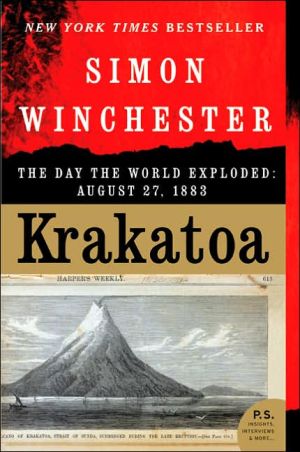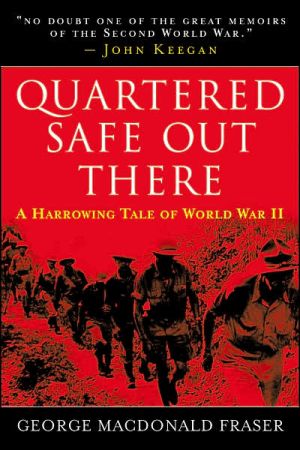Krakatoa: The Day the World Exploded: August 27, 1883
The legendary annihilation in 1883 of the volcanoisland of Krakatoa -- the name has since become a byword for cataclysmic disaster -- was followed by an immense tsunami that killed nearly forty thousand people. Beyond the purely physical horrors of an event that has only very recently been properly understood, the eruption changed the world in more ways than could possibly be imagined. Dust swirled round the planet for years, causing temperatures to plummet and sunsets to turn vivid with...
Search in google:
In this first US edition, the author of the The Map That Changed the World portrays the 19th-century eruption of a Javanese volcano that still has global repercussions in both historical and scientific contexts. The book includes maps and other illustrations. Published in Great Britain by Viking, 2003. Annotation © 2004 Book News, Inc., Portland, OR The Los Angeles Times Simon Winchester has in Krakatoa: The Day the World Exploded: August 27, 1883, written an exhaustive and often exciting account of the Krakatoa events. In particular, it is outstanding in describing the sequence of events from 1:06 p.m., the moment of the first great explosion, on Aug. 26, 1883, to the immediate aftermath of the climactic blast of 10:02 a.m. the following day. — Kenneth Reich
List of Illustrations and MapsPrelude171"An Island with a Pointed Mountain"282The Crocodile in the Canal713Close Encounters on the Wallace Line934The Moments When the Mountain Moved1915The Unchaining of the Gates of Hell2416A League from the Last of the Sun2857The Curious Case of the Terrified Elephant3148The Paroxysm, the Flood, and the Crack of Doom3309Rebellion of a Ruined People49810The Rising of the Son531Epilogue: The Place the World Exploded575Recommendations for (and, in One Case, Against) Further Reading and Viewing603Acknowledgments, Erkenningen, Terima Kasih621
\ Baltimore Sun"Winchester scores." (byline Baltimore Sun, printed in Pittsburg Post-Gazette)\ \ \ \ \ International Herald Tribune"The rich and fascinating KRAKATOA confirms [Winchester’s] preeminence. Janet Maslin\ \ \ New York Times"Brilliant...One of the best books ever written about the history and significance of a natural disaster."\ \ \ \ \ Chicago Sun-Times"Winchester...is noted for his ability to turn scholarly history into engrossing narrative."\ \ \ \ \ Entertainment Weekly"A real-life story bigger than any Hollywood blockbuster."\ \ \ \ \ San Francisco Chronicle"Winchester’s exceptional attention to detail never falters."\ \ \ \ \ Boston Sunday Globe"Krakatoa is a pleasure from beginning to end."\ \ \ \ \ The Economist"Masterful build-up of literary and geological tension."\ \ \ \ \ Daily News"Winchester dramatically delivers...the book is absorbing..."\ \ \ \ \ Washington Post Book World"A good read."\ \ \ \ \ USA TodayBuilding thrillerlike suspense, Winchester gives voice to firsthand accounts from scientists, ship captains and local observers of the buildup of volcanic activity that ended so spectacularly. He also presents the men who pieced together geological information, culminating in plate tectonics theory. If you've ever sat through a dry geology lecture, Winchester's human-oriented volcanology will grip you. — Ayesha Court\ \ \ \ \ The Washington PostPart history, scientific detective story and travelogue, with all the storytelling zeal of his bestselling The Map that Changed the World, Winchester's new book complements the more scholarly approach of earlier volumes on the subject. With an eye for the smallest detail (we learn that a Dutch scientist's wife lost an heirloom Delft dinner plate during one of Krakatoa's earlier rumblings) and a solid understanding of geology, Winchester's narrative culminates in an hour-by-hour account from the viewpoints of ship captains, a telegraph operator, a British consul and a Dutch colonial official. There are some problems in his coverage of events before and after the eruption, but this is a good read for anyone interested in Indonesia, geology or earthshaking catastrophes. — Valerie Jablow\ \ \ \ \ The Los Angeles TimesSimon Winchester has in Krakatoa: The Day the World Exploded: August 27, 1883, written an exhaustive and often exciting account of the Krakatoa events. In particular, it is outstanding in describing the sequence of events from 1:06 p.m., the moment of the first great explosion, on Aug. 26, 1883, to the immediate aftermath of the climactic blast of 10:02 a.m. the following day. — Kenneth Reich\ \ \ \ \ The New YorkerWhen Hurricane Zoe hit the SOLOMON ISLANDS last December, it took several days before anyone could reach the most remote islands, Tikopia and Anuda, to assess the damage. But isolation this extreme was precisely what the former high-school teacher Will Randall sought on Randuvu, where he taught the islanders to raise chickens. Randall narrates his agrarian adventure in Solomon Time, during which he happily fell into a pace of life that he says makes "schedules and timetables become irrelevancies, arrangements, meetings, deadlines inconsequential."\ \ \ The romance of the remote also seems to have infected Katherine Routledge, who, in 1914, became one of the first archeologists to investigate Easter Island. Among Stone Giants, Jo Anne Van Tilburg's biography of Routledge, tells how the island's statues provoked her to rapturous imaginings of the rituals that might have taken place there. Back in England, Routledge declined into schizophrenia -- a condition her family blamed on the influence of Angata, a mysterious native visionary.\ Krakatoa: The Day the World Exploded, Simon Winchester focuses on more physical dangers: the seismic events of August 27, 1883, when the Javanese island vanished in a volcanic eruption of almost unimaginable power. The explosion was heard as far away as Australia, and the tidal waves that followed killed some forty thousand people. Winchester, a geologist, looks at both the aftermath of the eruption and its geological inevitability. Apparently, the island over the volatile site, where one tectonic plate slides under another, explodes with relative regularity. Krakatoa's successor, which appeared on the site in 1930, is growing at a rate of twenty feet every year.\ ( Leo Carey)\ \ \ \ \ The New York TimesLike its subject, Winchester's book is rife with superlatives. Here is his description of the giant wave that drowned Merak: ''This too was Krakatoa's most colossal wave, the biggest consequence of the biggest and final explosion. It was a wave so enormous and so powerful that it turned out to be the grimmest of grim reapers, the terrible climax to a long and deadly day.'' Krakatoa (the volcano) wasn't the largest or deadliest of recent Indonesian volcanic eruptions. That dubious distinction goes to Tambora, which erupted with more than twice the power of Krakatoa, killed 10,000 people outright and caused the death of another 82,000 by starvation and disease. Krakatoa (the book) is, also like its subject, deserving of superlatives: It is thrilling, comprehensive, literate, meticulously researched and scientifically accurate; it is one of the best books ever written about the history and significance of a natural disaster. — Richard Ellis\ \ \ \ \ TimeKrakatoa is volcanic.\ \ \ \ \ Eric WargoThe 1883 volcanic eruption on the island of Krakatoa, near Java, was the most devastating disaster of its kind in history. It killed almost forty thousand people and made one of the loudest sounds ever heard (it was heard more than three thousand miles away—like an explosion in San Francisco being heard in Philadelphia. Airborne ash caused worldwide temperatures to plummet and produced brilliant pink sunsets for months. Once the dust cleared, the island itself, and its signature 2, 625-foot-high cone, had disappeared. Winchester, a former geologist and author of The Professor and the Madman and The Map That Changed the World, not only explains the subterranean forces that produced the volcano, but also charts its far-reaching social ramifications, including the first instances anywhere of anti-Western violence by Islamic fundamentalists (in this case, in the hard-hit Dutch East Indies. A lesser writer would have trouble juggling such diverse topics as the seventeenth-century pepper trade, nineteenth-century Islamic nationalism and the geological processes that cause continents to drift and collide, but Winchester uses the disaster, which became a worldwide media event, to incorporate these stories (and many others into one mightily fascinating book.\ \ \ \ \ Publishers WeeklyAn erudite, fascinating account by one of the foremost purveyors of contemporary nonfiction, this book chronicles the underlying causes, utter devastation and lasting effects of the cataclysmic 1883 eruption of the volcano island Krakatoa in what is now Indonesia. Winchester (The Professor and the Madman; The Map That Changed the World) once again demonstrates a keen knack for balancing rich and often rigorous historical detail with dramatic tension and storytelling. Rather than start with brimstone images of the fateful event itself, Winchester takes a broader approach, beginning with his own viewing of the now peaceful remains of the mountain for a second time in a span of 25 years-and being awed by how much it had grown in that time. This nod to the earth's ceaseless rejuvenation informs the entire project, and Winchester uses the first half of the text to carefully explain the discovery and methods of such geological theories as continental drift and plate tectonics. In this way, the vivid descriptions of Krakatoa's destruction that follow will resonate more completely with readers, who will come to appreciate the awesome powers that were churning beneath the surface before it gave way. And while Winchester graphically illustrates, through eyewitness reports and extant data, the human tragedy and captivating scientific aftershocks of the explosion, he is also clearly intrigued with how it was "a demonstration of the utterly confident way that the world, however badly it has been wounded, picks itself up, continues to unfold its magic and its marvels, and sets itself back on its endless trail of evolutionary progress yet again." His investigations have produced a work that is relevant to scholars and intriguing to others, who will relish it footnotes and all. (Apr.) Copyright 2003 Reed Business Information.\ \ \ \ \ Library JournalIn 1883, Krakatoa, the largest volcanic eruption in modern history, killed thousands, caused worldwide climactic changes, and induced massive political and social upheaval in Java. Noted science writer Winchester tackles this interesting subject in his usual eclectic and charming manner. Geology, history, biology, and politics all play a role. From 16th-century European merchant invaders to 19th-century evolutionary theorist Henry Wallace to 20th-century magnetic pole data from Greenland, the author has compiled and organized massive amounts of data. The result is a fascinating picture of the Krakatoa disaster, from causes to consequences. Competently read by the author (with an occasional chuckle in his voice), Krakatoa would be an excellent choice for moderate to large public library collections.-I. Pour-El, Des Moines Area Community Coll., Boone, IA Copyright 2003 Reed Business Information.\ \ \ \ \ School Library JournalAdult/High School-This expansive chronicle of a geologically unstable hot spot between the islands of Java and Sumatra, scene of the cataclysmic 1883 eruption of Krakatoa, conveys not only a wealth of scientific detail related to the event, but also addresses long-term ramifications for the social, political, economic, and religious fabric of the region. During the volcano's final 20 hours and 56 minutes, sounds from Krakatoa's eruption were heard 2968 miles away, and the air shock waves it created were recorded circling the globe seven times. Ultimately, the "six cubic miles of rock" that had been the island vanished. Winchester points out that Krakatoa was the first catastrophe to occur "after the establishment of a worldwide network of telegraph cables" that enabled news of the devastation to be transmitted with heretofore unheard of speed. Scientific investigations continue to this day, with particular watchfulness over Anak Krakatoa (literally, "son of Krakatoa"), an active volcanic island located in the same spot, which began forming in 1927-1930 and is growing in height at a rate of 20 feet per year. The author cuts a broad swath as he transitions among topics as diverse as plate tectonics, the 16th-century Dutch-colonial spice trade, and the seeds of radical Islamic fundamentalism in Indonesia, but the telling is masterful and conscientious readers are rewarded by his elucidation of complex interrelationships.-Lynn Nutwell, Fairfax City Regional Library, VA Graphic Novels Copyright 2003 Reed Business Information.\ \ \ \ \ Kirkus ReviewsA vivid reconstruction of a volcanic explosion felt around the world--and a tale of curious twists it is. One of the most entertaining science-explainers at work today, Winchester (The Map That Changed the World, 2001, etc.) brings fine credentials to bear on writing the story of Krakatoa: both a former Asia correspondent for the Manchester Guardian and an Oxford-trained geologist, he has an eye for the local and global significance of that volcano’s cataclysmic eruption 120 years ago. Dotting his narrative with learned asides and digressions (including a lively account of a volcano-hunting field trip to Greenland in his student days), Winchester carefully builds a dramatic tale that begins with a few rumblings and ends with the end of the world as the Spice Islanders knew it. Like the volcano, his story takes its time in building force, but it steadily gathers strength while giving the reader a crash course in tectonic theory, continental drift, volcanism, and other elemental matters. Winchester seeds that story with all manner of curious actors, including a hapless fellow who, in one of the giant tsunamis generated by the eruption, "reportedly found himself being swept inland next to a crocodile: He clambered on to its back and hung on for grim death with his thumbs dug deep into the creature’s eye-sockets." Not only did the explosion lead to the erasure of the volcanic island of Krakatoa from the world map and kill nearly 40,000 people, Winchester writes, but it was also felt halfway around the world, with its plume of ash and smoke blackening the skies over London and New York. Moreover, he adds, the explosion caused a wave of anti-Western violence in predominantly Muslim Indonesia,perhaps contributing to the eventual expulsion of the Dutch colonialists from the islands. Though widely reported at the time and even today a byword for natural disaster, the explosion of Krakatoa figures only occasionally in the literature, Winchester writes--and, he adds, in a terrible disaster movie of the 1960s, which "for some reason . . . enjoys the status of a minor cult classic" in Britain. Supremely well told: a fine exception to the dull run of most geological writing.\ \








